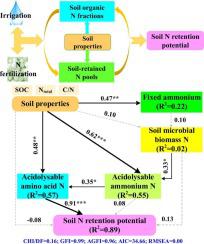Agriculture, Ecosystems & Environment ( IF 6.0 ) Pub Date : 2022-09-23 , DOI: 10.1016/j.agee.2022.108185 Hanqing Wu , Liyuan Zhang , Jindong Lv , Yuling Zhang , Yulong Zhang , Na Yu

|
Soil nitrogen (N) retention capacity can influence crop production, soil health, and environmental quality, especially in greenhouse agroecosystem with multiple cropping and high N application rate. However, the key N components and indices for predicting greenhouse soil N retention potential and the underlying driving mechanism of soil N retention under different agricultural management practices remain elusive. Here, a three-year tomato field experiment with mulch-film drip irrigation was conducted to investigate the effects of different irrigation and N fertilization regimes on soil organic N fractions and soil-retained N pools in a greenhouse agroecosystem of Northeast China. Three irrigation levels (W1, high, 25 kPa; W2, moderate, 35 kPa; W3, low, 45 kPa) and three N application rates (N1, low, 75 kg N ha−1; N2, moderate, 300 kg N ha−1; N3, high, 525 kg N ha−1) were considered. The results showed irrigation, N fertilization, and their interactions profoundly influenced soil properties, organic N fractions, and soil-retained N pools at 0–30 cm greenhouse vegetable soil layers. The dominant forms of greenhouse soil organic N fractions and soil-retained N pools were acidolysable amino acid N (AAN) and fixed ammonium (FA), respectively. Structural equation modeling and redundancy analysis indicated that there were significant direct effects of soil properties (SOC, Ntotal, and C/N) on FA, acidolysable ammonium N (AN), and AAN; additionally, soil microbial biomass N (SMBN) also exerted a significant direct effect on AN. Our results suggest that soil organic N fractions are closely correlated with soil-retained N pools and soil properties under different irrigation and N fertilization regimes. Furthermore, AAN and FA could be the appropriate indicators for predicting greenhouse soil N retention potential, and the optimization of irrigation and N fertilization application schedule (W3N2 treatment: 45 kPa – 300 kg N ha−1) is conducive to improve soil N retention potential in greenhouse tomato production of Northeast China.









































 京公网安备 11010802027423号
京公网安备 11010802027423号